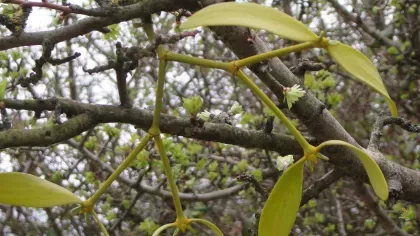18 December 2018
Weird weather and forgotten fruits
After an excellent season for fruiting, Mike Fay considers some of our less familiar species and their uses.

Fruits at Christmas
Christmas is strongly linked with fruit: cranberry sauce, Christmas pudding, mince pies and crystallized figs are all seasonal fare. Here I highlight some of our once more-popular wild fruits and their traditional uses.
A good year for fruit, for birds and people
At Kew, like much of the rest of the UK, 2018 has been a strange year. The “beast from the east” brought snow in February and March, and this was followed by a wet May and a prolonged hot, dry period from June to August.
Many of our plants at Kew fruited heavily this year. Whether this was due to the cold winter, mild spring or the hot summer (or the combination), the fruits will serve as a welcome food source for thrushes and other birds over winter.
We also pick and eat some wild-foraged fruits, but even a few generations ago our ancestors ate a wider range, often preserving them for use in the winter; many recipes exist and are still occasionally used. Some fruits received renewed attention in the 1970s due to books on foraging like Richard Mabey’s Food for Free, and there is a new resurgence today to make the most of our wild harvest.
The heather family
Cranberries (Vaccinium species; Ericaceae) are commonly associated with Christmas, but those eaten today as a sauce are in fact an American species (V. macrocarpon), widely cultivated in North America and in central Europe for its relatively large fruits that can be harvested mechanically - our native cranberry (V. oxycoccus) fell out of favour as its small berries need to be collected by hand. My memory of collecting them as a child in northern England involves wet feet and mosquito bites, as they grow in boggy areas. We used to turn them into sauce (easily as good as that made with American cranberries), but collecting enough for even a small batch took a long time!
Other native Ericaceae were also previously used in greater quantities. Bilberries (Vaccinium myrtillus) were collected for making pies and a tasty (but pippy) jam, but again their small fruits and the increasing availability of the large-fruited American blueberry (V. corymbosum) have led to a decline in their use. Now mostly eaten as a snack when out walking in the fells, bilberries lead to stained hands and clothes! Cowberries (V. vitis-idaea), rarely collected in the UK, are popular (as lingon) in Sweden.


The rose family
Rosaceae also provide many edible fruits (e.g. apples, plums and, raspberries). Rose hips (Rosa species) were collected for syrup during World War II, when other sources of vitamin C were in short supply. Sloes (Prunus spinosa), inedible raw, make a good jelly and, of course, sloe gin, conveniently ready in time for Christmas.
Many wild relatives of apples and pears, including haws and medlars (Crataegus species), rowan, service berries and whitebeams (Pyrus/Sorbus species), have been used to make jellies, wine and liqueurs. Medlars and service berries have to “blet” (begin to rot) before they can be eaten - their astringent taste becomes tempered by the first frosts of autumn.
At Kew, we have been studying rowan and its relatives since the 1990s. In Britain, there are more than 30 native species, and the relationships are among the most complex in our flora. DNA fingerprinting techniques are helping us clarify their relationships, but we still have more work to do!
Whether you stick to cranberries and dried raisins or decide to be more adventurous, I hope you enjoy some fruit over the holidays.



References
Pellicer, J. et al. (2012). Cytotype diversity in the Sorbus complex (Rosaceae) in Britain: sorting out the puzzle. Annals of Botany 110: 1185–1193. Available online
Plants of the World. Available in the Kew shop



